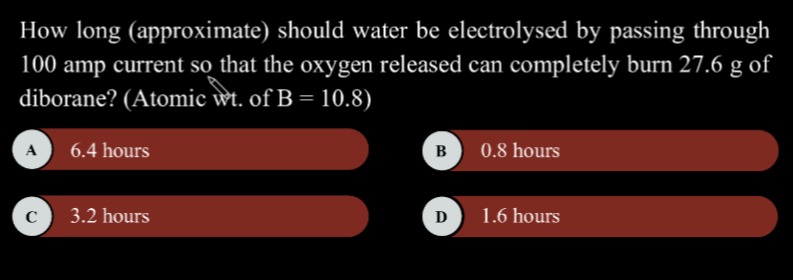Question
Question: How long (approximate) should water be electrolysed by passing through 100 amp current so that the o...
How long (approximate) should water be electrolysed by passing through 100 amp current so that the oxygen released can completely burn 27.6 g of diborane? (Atomic wt. of B = 10.8)

6.4 hours
0.8 hours
3.2 hours
1.6 hours
3.2 hours
Solution
The balanced equation for the combustion of diborane (B2H6) is:
B2H6(g)+3O2(g)⟶B2O3(s)+3H2O(l)
The molar mass of diborane (B2H6) is calculated using the given atomic weight of B = 10.8 and the atomic weight of H = 1 (approximately).
Molar mass of B2H6=2×Atomic wt. of B+6×Atomic wt. of H=2×10.8+6×1=21.6+6=27.6 g/mol.
The number of moles of 27.6 g of diborane is:
Moles of B2H6=Molar massMass=27.6 g/mol27.6 g=1 mole.
From the balanced combustion equation, 1 mole of B2H6 requires 3 moles of O2 for complete combustion.
So, we need 3 moles of O2.
Oxygen is produced by the electrolysis of water. The half-reaction for the production of oxygen at the anode is:
2H2O(l)⟶O2(g)+4H+(aq)+4e−
This equation shows that 1 mole of O2 is produced by the transfer of 4 moles of electrons.
To produce 3 moles of O2, the number of moles of electrons required is 3×4=12 moles.
According to Faraday's laws of electrolysis, the charge of one mole of electrons is equal to one Faraday (F), which is approximately 96500 Coulombs.
The total charge required to produce 3 moles of O2 is Q=Number of moles of electrons×F=12×96500 C.
The relationship between charge (Q), current (I), and time (t) is Q=I×t.
We are given the current I=100 A. We need to find the time t.
12×96500=100×t
t=10012×96500 seconds
t=12×965 seconds
t=11580 seconds.
To convert the time from seconds to hours, we divide by 3600 (number of seconds in an hour).
t(in hours)=360011580=3601158=60193 hours.
Now, we convert the fraction to a decimal or mixed number:
60193=60180+13=3+6013 hours.
6013 hours =6013×60 minutes =13 minutes.
So, the time is 3 hours and 13 minutes.
In decimal form, 60193=3.2166... hours.
The question asks for the approximate time. Comparing this value with the given options:
The value 3.2166... hours is closest to 3.2 hours.
